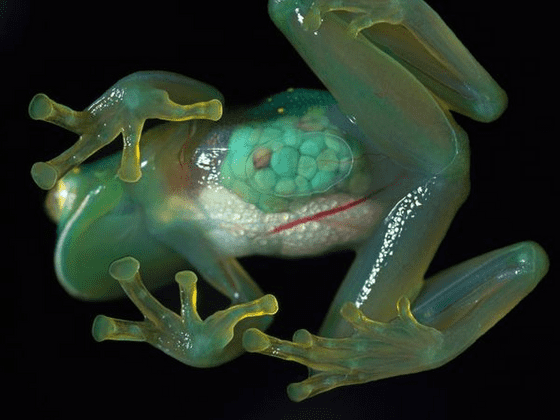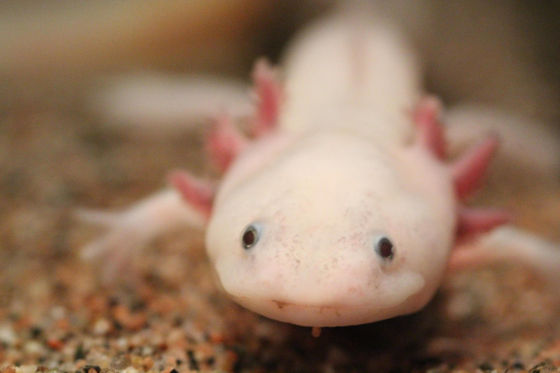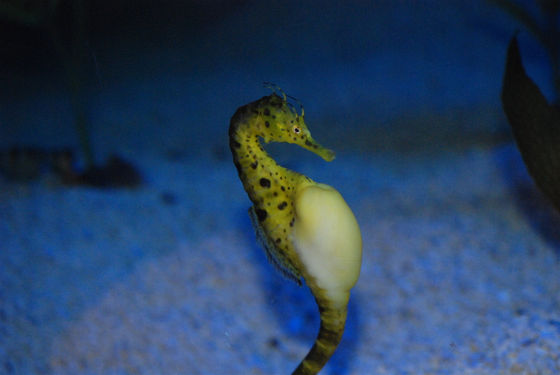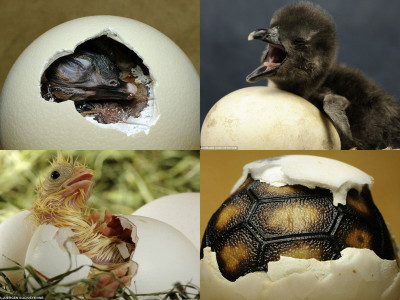6 strange creatures that exist in nature

There are a wide variety of animals in the world, including
6 weird animals that evolution came up with | Live Science
https://www.livescience.com/weird-animals-evolution.html
◆ 1: Transparent frog
When you see almost all living things, you see the skin, but some of them have transparent skin. 'Glass frog (frog glass)' with the nickname that in English tree frog beetle some species of the family, strange creatures as its nickname 'the skin of the ventral semi-transparent' called. When viewed from the ventral side, the appearance of food passing through the gastrointestinal tract and the heart moving with a pounding can be observed through the skin.

by
Regarding the mystery of how some of the tree frogs obtained transparent skin, a study published in June 2020 stated that 'the tropical rainforests of Central and South America where the tree frogs live have many greens such as overgrown vegetation. Therefore, the bright green color on the back side has the effect of blending into the surroundings, and the transparent skin on the ventral side has the effect of blurring the contours of the body, resulting in a camouflage effect. '
◆ 2: A bee that ends his life in a fig
Fig is a fruit tree that is widely cultivated all over the world, but wild species have a symbiotic relationship with a small bee called fig bee. Male fig bees that hatch in the fruit have a strange ecology that they die in the fruit without seeing the outside world.
Female fig bees also hatch in the fruit, except that they go out to the outside world after mating with males. The female who went out to the outside world sniffed out the fig tree in the preparatory stage of pollination and landed on the fig flower based on the smell. It invades through the opening at the tip of the fruit, but because the opening is very narrow, it loses its wings and tactile sensation in the process of invading. Females that have lost their lives and invaded the inside of the fruit die only 24 hours after spawning.
Figure 5: Spawning of a female fig bee-YouTube
Since the female fig wasp entering the fruit remains to adhere the pollen to the body, fig wasps are fig pollinators plays the role of. In addition, fig bees do not inhabit Japan, and most of the figs cultivated in Japan are parthenocarpy varieties that do not require pollination of fig bees.
◆ 3: Amphibians that mature while retaining the characteristics of larvae
In Nahuatl, which is used in the Aztec civilization with the name axolotl a combination of the 'dog' and 'water' Mexico salamander is unusual feature 'that mature while retaining the features of the larvae neoteny (iodine-type mature) shows the' seed. Amphibians have gills and breathe gills during larval stage, but when they metamorphose and become adults, they shift to lung and cutaneous respiration. However, Axolotl inherits the gills and tail on both sides of the head from larval stage and continues to breathe gills even when they become adults.

by
In the habitat near Mexico, Axolotl has long been at the top of the food chain, but the population is declining due to the invasion of alien species such as tilapia and carp and environmental pollution.
◆ 4: Fish born by males
In Japan, the seahorse , which was named because its appearance is similar to a dragon, is famous not only for its appearance that is almost invisible to fish, but also for its ecology that 'males protect eggs in the abdomen'. The male's abdomen has a bag called a pouch, which protects the eggs laid by the female until they become fry.

by Adam
Regarding the reason why seahorses have reached such an ecology, it has been confirmed that females become pregnant immediately after giving birth by leaving the hatching to males, and since it consumes a lot of energy at the time of giving birth, it is necessary to hatch afterwards. It is believed that males are responsible for equalizing energy consumption.
◆ 5: Fish that males parasitize females
Anglerfish is known as a fish with a gender difference, but among them, the Triplewart Seadevil, which lives in the deep sea, is a species with an overwhelming physical disparity between men and women, and females are about 60 in length compared to males. Double, the weight reaches about 500,000 times.
Adult Female Ceratioid Most Anglerfish Have A Luminescent Organ Called The Esca Used To Lure In Prey. #Mmbio Attomeltonkhs Is Not She Cute? Pic.Twitter.Com/AuUVD0fIes
— Addie Godsy (@addiegodsy) November 16, 2016
The male Ceratiidae, who found the female, uses its hook-shaped teeth to bite into the body, sucking blood and ingesting nutrients while integrating with the female. During this process of unification, males no longer need to swim, resulting in a gradual loss of major organs in addition to eyes and fins. When the female is ready to breed, the female releases the egg and at the same time the male releases sperm for in vitro fertilization.
◆ 6: Immortal jellyfish
All human beings eventually die, but there are immortal creatures in the world. Turritopsis nutricula , which inhabits temperate and tropical regions around the world, has been confirmed to return from sexually mature males to premature polyps. Turritopsis nutricula is attracting attention as an immortal jellyfish because the process of returning from this mature state to the immature state is theoretically infinitely possible.
Turritopsis sp. In 2020 --YouTube
The mechanism of immortality of turritopsis nutricula is being elucidated by genome analysis.
Related Posts:







